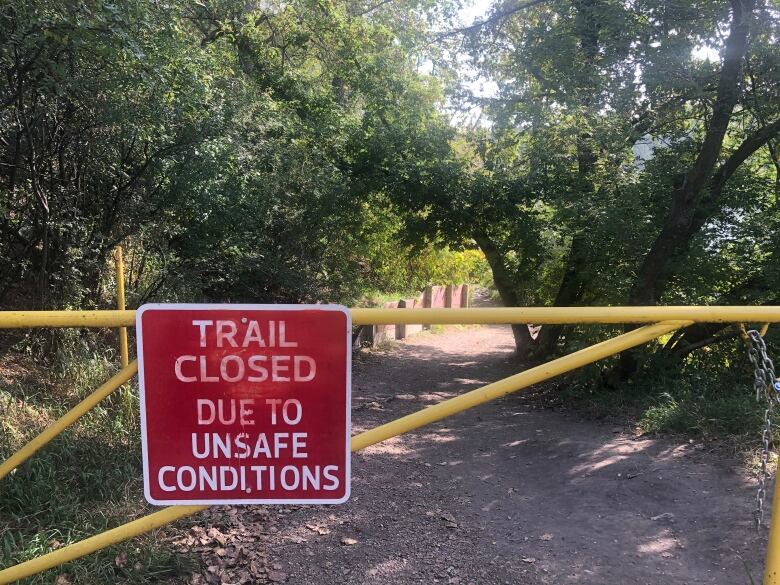Not so happy trails: Rain leads to more landslides, erosion in Edmonton's river valley
Volunteers have spent more than 500 hours clearing 33 kilometres of trails
A few years ago, Carina Ludgate noticed that some of her favourite trails in Edmonton's river valley were showing signs of erosion.
This spring, on walks with her basset hound, Edward, she stumbled upon more severe damage: in ravines and throughout the river valley, she found crumbled and split bike paths, eroded banks and washed-out trails.
One granular trail she visited had eroded and slumped into Mill Creek. The city has fenced the area off and is assessing it for a re-route.
"We didn't go back to Mill Creek since the start of spring just because the trail is so bad there," Ludgate told CBC News.
Ludgate guessed high water levels were to blame for much of the damage she found.
It turns out, she's right.
"Significant rainfall in 2019 and 2020 has contributed to a greater number of new landslide hazards and trail erosion throughout Edmonton," said city spokesperson Debi Winwood in an email.
Several high water events in the North Saskatchewan River also damaged trails, she added.
According to the city's river valley trail cautions and closures map as of Friday afternoon, there were 29 sections of trail that are under construction, permanently or temporarily closed, or where caution is advised.
Although the city updates its trail map regularly, there are sometimes discrepancies. For example, the Highlands lower trail was not added to the list until this week, despite being closed for months.
Winwood says the lower trail is currently under assessment to be considered for reopening.
More work for trail maintainers
The damage this year has meant more work for Edmonton's volunteer trail maintenance crews.

Kent Zucchet, who leads the trail maintenance teams for the Edmonton Mountain Bike Alliance, said when mountain bikers, trail runners and walkers use very wet trails, they can create potholes, which collect water and take a long time to dry out.
Zucchet and his volunteers drain the potholes and fill them with dirt. They also clear deadfall and occasionally build new trails, when the city permits them.
This year so far, EMBA volunteers have spent more than 500 hours clearing 33 kilometres of trails.
When will trails reopen?
Some trails have reopening dates on the horizon; the paved path behind Old Timers Cabin is scheduled to reopen at the end of the summer and re-routing work in Tiger Goldstick Park has an end date of December.
Others are listed as temporary closures but have no end date. Trails with more severe damage could be closed for months, if not longer.

City engineers have to plan and evaluate repairs, Winwood said. Sites where infrastructure is threatened or compromised get priority.
Engineers' investigations and the environmental regulation process contributes to the long wait.
"Geological surveys take an extraordinary amount of time," said Zucchet, an engineer himself.
If a trail slumps, he said, it can take the city more than a year to evaluate whether it's safe to reopen it.
Despite this year's environmental obstacles, there is good news for trail users.
Winwood says the city is working to improve its trail system by repairing and maintaining its existing river valley paths. The city is also adding stairways and other trail connections to make the river valley more accessible.

